This is the most comprehensive series of courses on pelvic girdle and sacroiliac dysfunction that you can find on the Internet.
Sacroiliac dysfunction affects an estimated 10-30% of people with unspecific lower back pain and is often present with complaints of hip and leg pain on the same side. It is often undiagnosed and can actually be one of the causes of low back pain.
Pelvic girdle and sacroiliac pain affect 56-72% of women during pregnancy and after childbirth and 7% continue to experience pain and dysfunction for the rest of their lives. Physiotherapists are best suited to help these patients.
In this new course program, Deborah Riczo guides you through the Pelvic Girdle Musculoskeletal Method (PGM) and gives you the tools to make your patients with Pelvic Girdle Dysfunction (PGD) easy, effective and accurate to be treated).
The tutor
Dr. Deborah Riczo is a specialist in pelvic girdle / sacroiliac dysfunction, pregnancy / postpartum problems, women's health and breast cancer.
Deborah Riczo is a renowned speaker and author on pelvic girdle / sacroiliac pain and dysfunction. She is a licensed physical therapist in the state of Ohio and has a BS in Physiotherapy and Med Sports Management from Cleveland State University and a DPT from Marymount University.
Deborah is a leading expert in the assessment and treatment of pain and dysfunction of the sacroiliac / pelvic girdle. She is also a specialist in pregnancy / puerperium problems, women's health and breast cancer. Deborah is the author of two books on these subjects. In 2011, Deborah founded Riczo Health Education and developed advanced training courses for therapists in her areas of expertise. She also teaches sacroiliac / pelvic girdle dysfunction at graduate level, through webinars, and at state and national conferences.

The program
Sacroiliac and pelvic girdle dysfunction – The PGM method
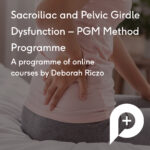 Sacroiliac dysfunction affects ~ 10-30% of people with unspecific low back pain and is often diagnosed with complaints of unilateral hip and leg pain. It often goes undiagnosed and is often a source of back pain. Pelvic girdle and sacroiliac pain affect 56-72% of women during pregnancy and after childbirth, and 7% experience pain and dysfunction for the rest of their lives. Physiotherapists are best placed to help these patients. Deborah Riczo developed the Pelvic Girdle Musculoskeletal Method (PGM) and, in the 12 courses in this program, will give you the tools to treat your pelvic girdle dysfunction (PGD) patients simply, effectively and accurately.
Sacroiliac dysfunction affects ~ 10-30% of people with unspecific low back pain and is often diagnosed with complaints of unilateral hip and leg pain. It often goes undiagnosed and is often a source of back pain. Pelvic girdle and sacroiliac pain affect 56-72% of women during pregnancy and after childbirth, and 7% experience pain and dysfunction for the rest of their lives. Physiotherapists are best placed to help these patients. Deborah Riczo developed the Pelvic Girdle Musculoskeletal Method (PGM) and, in the 12 courses in this program, will give you the tools to treat your pelvic girdle dysfunction (PGD) patients simply, effectively and accurately.
Explore the PGM method
The courses
Basic knowledge
Recognition of pelvic girdle pain
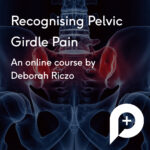 Pelvic girdle pain relates to diseases of the musculoskeletal system that affect the pelvis. The sacroiliac joint, the pubic symphysis and the associated ligaments and muscles are particularly affected. Pelvic girdle pain is a global problem, but physical therapists are in a unique position to provide guidance and valuable help to patients. In this course, the first in a series of courses on pelvic girdle pain, Deborah Riczo discusses the definition, causes, prevalence, risk factors, differential diagnosis, prognosis, and subjective clinical findings of pelvic girdle pain.
Pelvic girdle pain relates to diseases of the musculoskeletal system that affect the pelvis. The sacroiliac joint, the pubic symphysis and the associated ligaments and muscles are particularly affected. Pelvic girdle pain is a global problem, but physical therapists are in a unique position to provide guidance and valuable help to patients. In this course, the first in a series of courses on pelvic girdle pain, Deborah Riczo discusses the definition, causes, prevalence, risk factors, differential diagnosis, prognosis, and subjective clinical findings of pelvic girdle pain.
Correctly identify pelvic girdle pain
Anatomy of the pelvic girdle
 The dysfunction of the pelvic girdle can be a disabling disease and affect the daily function and quality of life of those affected. Physiotherapists often diagnose and treat musculoskeletal disorders that affect the pelvis, and an excellent understanding of the anatomy of the pelvic girdle is essential for good patient and treatment outcomes. This course by Deborah Riczo examines the anatomy of the pelvic girdle with a focus on the bones, joints, ligaments and muscles of the pelvis and surrounding areas.
The dysfunction of the pelvic girdle can be a disabling disease and affect the daily function and quality of life of those affected. Physiotherapists often diagnose and treat musculoskeletal disorders that affect the pelvis, and an excellent understanding of the anatomy of the pelvic girdle is essential for good patient and treatment outcomes. This course by Deborah Riczo examines the anatomy of the pelvic girdle with a focus on the bones, joints, ligaments and muscles of the pelvis and surrounding areas.
Test your pelvic anatomy
Biomechanics and dynamics of the pelvic girdle
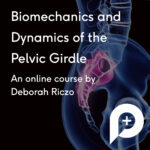 The pelvic girdle forms the connection and is also responsible for the load transfer between the lumbar spine and the lower extremities. The SIJ is the body's largest axial joint and an integral part of the pelvic girdle. This course looks at the biomechanics and neuromuscular dynamics of the pelvic girdle. It is of the utmost importance for physical therapists to have a thorough understanding of this area in order to effectively address pelvic girdle dysfunction in their patients.
The pelvic girdle forms the connection and is also responsible for the load transfer between the lumbar spine and the lower extremities. The SIJ is the body's largest axial joint and an integral part of the pelvic girdle. This course looks at the biomechanics and neuromuscular dynamics of the pelvic girdle. It is of the utmost importance for physical therapists to have a thorough understanding of this area in order to effectively address pelvic girdle dysfunction in their patients.
Discover the complicated mechanism of your pelvis
Pelvic girdle dysfunction Literature review
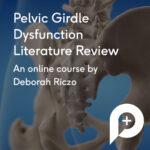 Various models of disorders and mechanical dysfunction have been proposed. Because of this diversity, there is little evidence to support many treatments. Even among experts in the field of pelvic girdle dysfunction and sacroiliac pain, there appears to be a consensus on how to diagnose and treat these dysfunctions. In this fourth course, Deborah provides us with an in-depth review of the available evidence on the diagnosis, interventions, and outcome measurements of pelvic girdle dysfunction.
Various models of disorders and mechanical dysfunction have been proposed. Because of this diversity, there is little evidence to support many treatments. Even among experts in the field of pelvic girdle dysfunction and sacroiliac pain, there appears to be a consensus on how to diagnose and treat these dysfunctions. In this fourth course, Deborah provides us with an in-depth review of the available evidence on the diagnosis, interventions, and outcome measurements of pelvic girdle dysfunction.
Expand your knowledge of EBP
The pelvic girdle musculoskeletal method
Introduction to the pelvic girdle musculoskeletal method
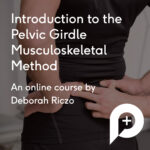 The treatment of pelvic girdle dysfunction is complex and there are many different approaches in practice. In this course, Deborah introduces the Pelvic Girdle Musculoskeletal Method, or PGM Method, which Deborah developed and has taught physical therapists for 201. This method enables physiotherapists to safely assess the dysfunction of the pelvic girdle and to implement targeted treatment plans that are intended to improve the day-to-day functioning and quality of life of their clients.
The treatment of pelvic girdle dysfunction is complex and there are many different approaches in practice. In this course, Deborah introduces the Pelvic Girdle Musculoskeletal Method, or PGM Method, which Deborah developed and has taught physical therapists for 201. This method enables physiotherapists to safely assess the dysfunction of the pelvic girdle and to implement targeted treatment plans that are intended to improve the day-to-day functioning and quality of life of their clients.
Transform your holistic approach to the pelvis
The pelvic girdle musculoskeletal method – pelvic compensation exercises
 In this sixth course on the pelvic girdle musculoskeletal method or PGM method, Deborah Riczo presents an algorithm of exercises, the PGM method, pelvic compensation exercises, which are intended to contribute to pain relief and improved function. These exercises can easily be applied in a clinical or virtual setting and prescribed as a home exercise for patients.
In this sixth course on the pelvic girdle musculoskeletal method or PGM method, Deborah Riczo presents an algorithm of exercises, the PGM method, pelvic compensation exercises, which are intended to contribute to pain relief and improved function. These exercises can easily be applied in a clinical or virtual setting and prescribed as a home exercise for patients.
PGM training algorithm
The PGM method – core activation, targeted strengthening and stretching of the pelvic girdle
 An important part of the PGM method is to activate the deep core muscles and to address weak and tense muscles. In this course, Deborah teaches how to activate the deep core muscles, introduces an algorithm that controls the progression of core strengthening, and identifies specific muscles that tend to require targeted stretching and strengthening in patients with pelvic girdle dysfunction.
An important part of the PGM method is to activate the deep core muscles and to address weak and tense muscles. In this course, Deborah teaches how to activate the deep core muscles, introduces an algorithm that controls the progression of core strengthening, and identifies specific muscles that tend to require targeted stretching and strengthening in patients with pelvic girdle dysfunction.
Improve your ability to teach new skills to patients
The PGM method – sacroiliac strap and patient training
 High quality patient education is an integral part of effective patient care in all healthcare facilities in order to improve clinical outcomes such as pain, disability and function. In this course, Deborah Riczo discusses the PGMsm patient education interventions and the use of the sacroiliac strap that are beneficial for patients with pelvic girdle dysfunction. It is recommended that these strategies be incorporated into the management of a patient with pelvic girdle dysfunction as appropriate.
High quality patient education is an integral part of effective patient care in all healthcare facilities in order to improve clinical outcomes such as pain, disability and function. In this course, Deborah Riczo discusses the PGMsm patient education interventions and the use of the sacroiliac strap that are beneficial for patients with pelvic girdle dysfunction. It is recommended that these strategies be incorporated into the management of a patient with pelvic girdle dysfunction as appropriate.
Add another notch to your treatment belt
Diastasis recti abdominis and pelvic floor muscle dysfunction
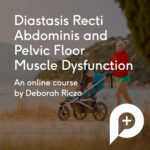 In this course, Deborah Riczo will discuss diastasis recti abdominis (DRA) and pelvic floor dysfunction. The signs, symptoms, assessment, and treatment options for these two conditions are covered. It is important that any physical therapist involved in treating patients with pelvic girdle dysfunction has a good understanding of both of these conditions.
In this course, Deborah Riczo will discuss diastasis recti abdominis (DRA) and pelvic floor dysfunction. The signs, symptoms, assessment, and treatment options for these two conditions are covered. It is important that any physical therapist involved in treating patients with pelvic girdle dysfunction has a good understanding of both of these conditions.
Safe management of the center line separation
The PGM method – core strengthening
 The trunk muscles are involved in maintaining the stability of the spine and pelvis. Physiotherapists regularly prescribe core strengthening exercises to patients with a variety of dysfunction and injuries. In this tenth course of the Pelvic Girdle Musculoskeletal Method, Deborah Riczo discusses core strengthening and teaches practical methods to systematically advance through different levels of core strengthening.
The trunk muscles are involved in maintaining the stability of the spine and pelvis. Physiotherapists regularly prescribe core strengthening exercises to patients with a variety of dysfunction and injuries. In this tenth course of the Pelvic Girdle Musculoskeletal Method, Deborah Riczo discusses core strengthening and teaches practical methods to systematically advance through different levels of core strengthening.
Basic core exercises
The PGM method – considerations on pregnancy and the puerperium
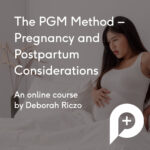 During pregnancy, the female body experiences a large number of anatomical and physiological changes. Because of these changes, women often experience pain and discomfort during pregnancy and in the postpartum period. The aim of this course is to provide an overview of some of the hormonal, cardiovascular, and musculoskeletal changes that occur during pregnancy and postpartum, as well as guidance on appropriate intervention strategies for common medical conditions during this phase.
During pregnancy, the female body experiences a large number of anatomical and physiological changes. Because of these changes, women often experience pain and discomfort during pregnancy and in the postpartum period. The aim of this course is to provide an overview of some of the hormonal, cardiovascular, and musculoskeletal changes that occur during pregnancy and postpartum, as well as guidance on appropriate intervention strategies for common medical conditions during this phase.
Become more holistic in your approach
Case studies on pelvic girdle dysfunction
 Summary of all elements in the treatment of patients with pelvic girdle pain using the PGM method. In this final course in the Pelvic Girdle Dysfunction Program, Deborah Riczo discusses 4 patients with different representations of pain. She uses the Pelvic Girdle Musculoskeletal (PGM) method in the assessment and successful treatment of these patients. It is highly recommended that you complete all previous courses in this program before completing this course.
Summary of all elements in the treatment of patients with pelvic girdle pain using the PGM method. In this final course in the Pelvic Girdle Dysfunction Program, Deborah Riczo discusses 4 patients with different representations of pain. She uses the Pelvic Girdle Musculoskeletal (PGM) method in the assessment and successful treatment of these patients. It is highly recommended that you complete all previous courses in this program before completing this course.
Test your PGM knowledge